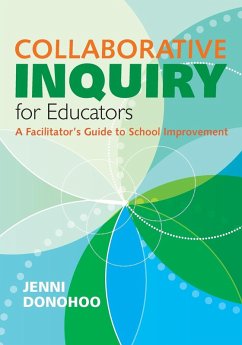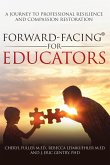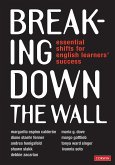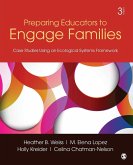Jenni Anne Marie Donohoo
Collaborative Inquiry for Educators
A Facilitator's Guide to School Improvement
Jenni Anne Marie Donohoo
Collaborative Inquiry for Educators
A Facilitator's Guide to School Improvement
- Broschiertes Buch
- Merkliste
- Auf die Merkliste
- Bewerten Bewerten
- Teilen
- Produkt teilen
- Produkterinnerung
- Produkterinnerung
Move teams toward impactful collaborative work, improved instruction, and increased student achievement using this guideà â  s scaffolded, step-by-step activities and real-world examples.
Andere Kunden interessierten sich auch für
![Forward-Facing® for Educators Forward-Facing® for Educators]() Cheryl Fuller M EdForward-Facing® for Educators28,99 €
Cheryl Fuller M EdForward-Facing® for Educators28,99 €![Forward-Facing® for Educators Forward-Facing® for Educators]() Cheryl Fuller M EdForward-Facing® for Educators22,99 €
Cheryl Fuller M EdForward-Facing® for Educators22,99 €![Breaking Down the Wall Breaking Down the Wall]() Margarita Espino CalderonBreaking Down the Wall31,99 €
Margarita Espino CalderonBreaking Down the Wall31,99 €![School Improvement Networks and Collaborative Inquiry School Improvement Networks and Collaborative Inquiry]() Mauricio Pino Yancovic (Pontifical Catholic University of ValparaisSchool Improvement Networks and Collaborative Inquiry63,99 €
Mauricio Pino Yancovic (Pontifical Catholic University of ValparaisSchool Improvement Networks and Collaborative Inquiry63,99 €![Identity Formation and Collaborative Inquiry Identity Formation and Collaborative Inquiry]() Carol BearseIdentity Formation and Collaborative Inquiry52,99 €
Carol BearseIdentity Formation and Collaborative Inquiry52,99 €![Social Justice Pedagogy Across the Curriculum Social Justice Pedagogy Across the Curriculum]() Social Justice Pedagogy Across the Curriculum43,99 €
Social Justice Pedagogy Across the Curriculum43,99 €![Preparing Educators to Engage Families Preparing Educators to Engage Families]() Heather B. WeissPreparing Educators to Engage Families95,99 €
Heather B. WeissPreparing Educators to Engage Families95,99 €-
-
-
Move teams toward impactful collaborative work, improved instruction, and increased student achievement using this guideà â  s scaffolded, step-by-step activities and real-world examples.
Produktdetails
- Produktdetails
- Verlag: SAGE Publications Inc
- Seitenzahl: 144
- Erscheinungstermin: 14. Mai 2013
- Englisch
- Abmessung: 254mm x 178mm x 8mm
- Gewicht: 316g
- ISBN-13: 9781452274416
- ISBN-10: 145227441X
- Artikelnr.: 37557683
- Herstellerkennzeichnung
- Libri GmbH
- Europaallee 1
- 36244 Bad Hersfeld
- gpsr@libri.de
- Verlag: SAGE Publications Inc
- Seitenzahl: 144
- Erscheinungstermin: 14. Mai 2013
- Englisch
- Abmessung: 254mm x 178mm x 8mm
- Gewicht: 316g
- ISBN-13: 9781452274416
- ISBN-10: 145227441X
- Artikelnr.: 37557683
- Herstellerkennzeichnung
- Libri GmbH
- Europaallee 1
- 36244 Bad Hersfeld
- gpsr@libri.de
Jenni Donohoo is the director of Praxis-Engaging Ideas, Inc and a project manager for the Council of Ontario Directors of Education (CODE). Jenni has a PhD in Educational Studies and Supervisory Officer Qualifications. Jenni is a former classroom teacher and currently works with system, school leaders, and teachers around the world to support high quality professional learning. She has authored many peer-reviewed publications and three best-selling books, including Collaborative Inquiry for Educators, The Transformative Power of Collaborative Inquiry (with Moses Velasco), and Collective Efficacy: How Educators' Beliefs Impact Student Learning. Jenni's areas of expertise include collective efficacy, metacognition, adolescent literacy, and facilitating collaborative learning structures.
Preface
Acknowledgments
About the Author
1. Why Collaborative Inquiry?
A Four-Stage Model
Getting Started
2. Stage 1: Framing the Problem
Determining a Meaningful Focus
Determining a Shared Vision
Developing an Inquiry Question
Formulating a Theory of Action
Reflection for Facilitators
3. Stage 2: Collecting Evidence
Developing Knowledge, Competencies, and Shared Understandings
Implementing Changes in Practice
Developing the Data Collection Plan
Reflection for Facilitators
4. Stage 3: Analyzing Evidence
Considering Implementation
Data Analysis
Examining Assumptions
Reflection for Facilitators
5. Stage 4: Documenting, Celebrating and Sharing
Documenting and Sharing
Celebrating
Debriefing the Process
Reflection for Facilitators
Resources
Resource A. Identifying Student Learning Needs
Resource B. Sphere of Concern Versus Realm of Control
Resource C. Examples of Purpose Statements
Resource D. Inquiry Questions--Examples--Strong and Weak
Resource E. Theory of Action T-Chart
Resource F. Innovation Configuration Map Template
Resource G. Data Collection Plan Template
Resource H. Levels of Implementation Templates
Resource I. Collaborative Inquiry Teams--Small Group Sharing
Resource J. Characteristics of Collaborative Inquiry Continuum
Resource K. Characteristics of Collaborative Inquiry--Start--Stop--Continue
References
Index
Acknowledgments
About the Author
1. Why Collaborative Inquiry?
A Four-Stage Model
Getting Started
2. Stage 1: Framing the Problem
Determining a Meaningful Focus
Determining a Shared Vision
Developing an Inquiry Question
Formulating a Theory of Action
Reflection for Facilitators
3. Stage 2: Collecting Evidence
Developing Knowledge, Competencies, and Shared Understandings
Implementing Changes in Practice
Developing the Data Collection Plan
Reflection for Facilitators
4. Stage 3: Analyzing Evidence
Considering Implementation
Data Analysis
Examining Assumptions
Reflection for Facilitators
5. Stage 4: Documenting, Celebrating and Sharing
Documenting and Sharing
Celebrating
Debriefing the Process
Reflection for Facilitators
Resources
Resource A. Identifying Student Learning Needs
Resource B. Sphere of Concern Versus Realm of Control
Resource C. Examples of Purpose Statements
Resource D. Inquiry Questions--Examples--Strong and Weak
Resource E. Theory of Action T-Chart
Resource F. Innovation Configuration Map Template
Resource G. Data Collection Plan Template
Resource H. Levels of Implementation Templates
Resource I. Collaborative Inquiry Teams--Small Group Sharing
Resource J. Characteristics of Collaborative Inquiry Continuum
Resource K. Characteristics of Collaborative Inquiry--Start--Stop--Continue
References
Index
Preface
Acknowledgments
About the Author
1. Why Collaborative Inquiry?
A Four-Stage Model
Getting Started
2. Stage 1: Framing the Problem
Determining a Meaningful Focus
Determining a Shared Vision
Developing an Inquiry Question
Formulating a Theory of Action
Reflection for Facilitators
3. Stage 2: Collecting Evidence
Developing Knowledge, Competencies, and Shared Understandings
Implementing Changes in Practice
Developing the Data Collection Plan
Reflection for Facilitators
4. Stage 3: Analyzing Evidence
Considering Implementation
Data Analysis
Examining Assumptions
Reflection for Facilitators
5. Stage 4: Documenting, Celebrating and Sharing
Documenting and Sharing
Celebrating
Debriefing the Process
Reflection for Facilitators
Resources
Resource A. Identifying Student Learning Needs
Resource B. Sphere of Concern Versus Realm of Control
Resource C. Examples of Purpose Statements
Resource D. Inquiry Questions--Examples--Strong and Weak
Resource E. Theory of Action T-Chart
Resource F. Innovation Configuration Map Template
Resource G. Data Collection Plan Template
Resource H. Levels of Implementation Templates
Resource I. Collaborative Inquiry Teams--Small Group Sharing
Resource J. Characteristics of Collaborative Inquiry Continuum
Resource K. Characteristics of Collaborative Inquiry--Start--Stop--Continue
References
Index
Acknowledgments
About the Author
1. Why Collaborative Inquiry?
A Four-Stage Model
Getting Started
2. Stage 1: Framing the Problem
Determining a Meaningful Focus
Determining a Shared Vision
Developing an Inquiry Question
Formulating a Theory of Action
Reflection for Facilitators
3. Stage 2: Collecting Evidence
Developing Knowledge, Competencies, and Shared Understandings
Implementing Changes in Practice
Developing the Data Collection Plan
Reflection for Facilitators
4. Stage 3: Analyzing Evidence
Considering Implementation
Data Analysis
Examining Assumptions
Reflection for Facilitators
5. Stage 4: Documenting, Celebrating and Sharing
Documenting and Sharing
Celebrating
Debriefing the Process
Reflection for Facilitators
Resources
Resource A. Identifying Student Learning Needs
Resource B. Sphere of Concern Versus Realm of Control
Resource C. Examples of Purpose Statements
Resource D. Inquiry Questions--Examples--Strong and Weak
Resource E. Theory of Action T-Chart
Resource F. Innovation Configuration Map Template
Resource G. Data Collection Plan Template
Resource H. Levels of Implementation Templates
Resource I. Collaborative Inquiry Teams--Small Group Sharing
Resource J. Characteristics of Collaborative Inquiry Continuum
Resource K. Characteristics of Collaborative Inquiry--Start--Stop--Continue
References
Index









